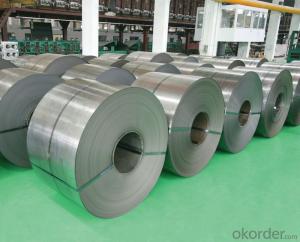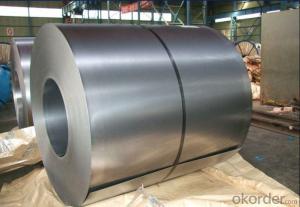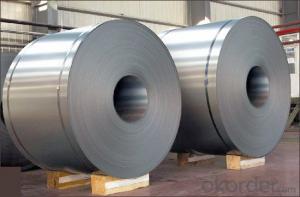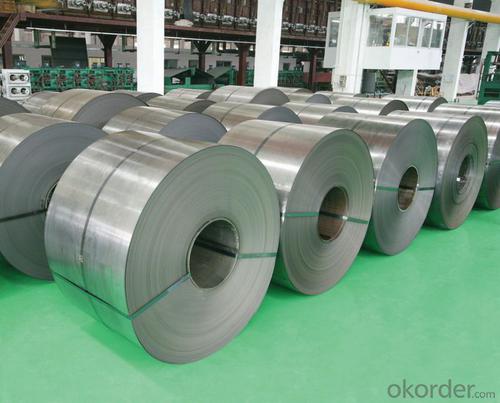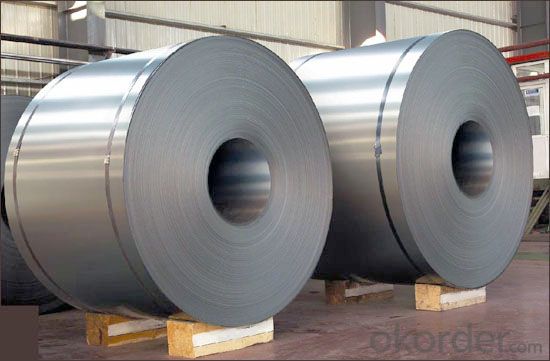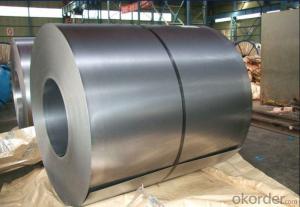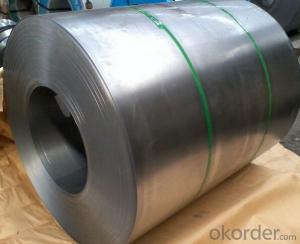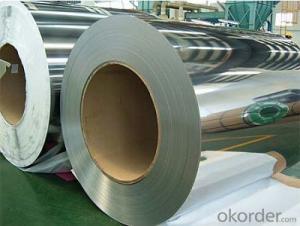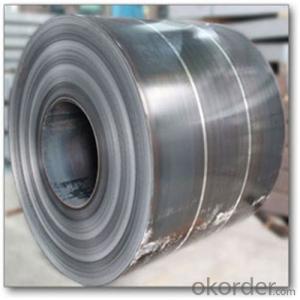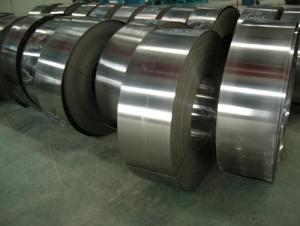COLD ROLLED STEEL COIL WITH HIGH QUALITY AND COMPETITVE PRICE NO.1
- Loading Port:
- Tianjin
- Payment Terms:
- TT OR LC
- Min Order Qty:
- 100 m.t.
- Supply Capability:
- 8000 m.t./month
OKorder Service Pledge
OKorder Financial Service
You Might Also Like
Cold rolled steel is the based material for galvanized steel coil and pre-painted galvanized steel coil. It is widely used in light industry for marking tank, furniture, refrigerators, washers, freezer plate, air conditioner, micro-wave oven, water heater, soot such machine etc.
Main specification:
COLD ROLLED STEEL | |
Thicknenss | 0.10mm-4.00mm |
Width | 600mm-2000mm |
Sheets length | 1200-6000mm |
Coil inner diameter | 508-610mm |
Surface treatement | matt finish/bright finish,oiling/dry, bright anneal/black anneal |
Coil weight | 3-5t |
We can supply customers' with different specifications of the highest quality and lowest price.
With excellent cold bending molded manufacturablity, good decoration effect, strong anti-corrosion ability, galvanized steel coils and sheets are also pollution-free and easily recycled. Accordingly, they can be used as final products and basic plates of color coated steel coils.
Sincerely welcome to contact us for the future details if any item interest you ,and we will make every effort to assure that your requirements will be satisfied ,and we hope to establish long-term business relations with you on the basis of the equality and mutual benefit.
We are waiting for your email.
- Q: How are steel coils used in the manufacturing of agricultural silos?
- Steel coils are used in the manufacturing of agricultural silos to create the cylindrical structure of the silo. These coils are rolled and shaped into large, seamless rings that form the walls of the silo. The coils provide strength and durability to withstand the weight of the stored grain or other agricultural products, ensuring the structural integrity of the silo.
- Q: Looking for an insight here into what hiking with steel toe-capped boots would be like, as I saw a nice pair of steel toed magnums that I plan to use for my future hiking (which I will be doing a fair amount of in the future). They seemed fairly comfortable, but I am curious into what others have to say and what might be known of this sort of approach. Thanks in advance.
- Steel toed boots are very heavy compared to hiking boots, after a long hike (especially in rough terrain) the extra weight is gonna tire you out. Steel toes are made for things like construction, or doing a task where extra protection of the toe is needed. So it's not ideal, but whatever floats your boat man (better than wearing tennis shoes). I personally have Converse composite toed boots from my airsofting days and since im too cheap to buy dedicated hike boots, I use it for hiking. Its supposedly made for military use and is much lighter than steel toe. But WAIT!!! lets say you dont have a gun or knife and you run into a pissed off Sasquatch, a steel toe boot too the nutz would do well in puttin the hurt on the dude.
- Q: How do steel coils contribute to sustainability in construction?
- Several factors contribute to the sustainability of construction when it comes to steel coils. To begin with, steel is an incredibly durable material with a long lifespan. Its use in the construction of structural components like beams, columns, and frames ensures the stability and strength of buildings. This durability translates to reduced maintenance requirements and a longer service life for structures. As a result, the need for frequent repairs or replacements is diminished, leading to a decrease in the overall environmental impact associated with material waste and energy consumption. Moreover, steel is highly recyclable. Steel coils can be easily recycled and reused in new construction projects. The recycling process for steel has a significantly lower environmental impact compared to the production of new steel. By incorporating recycled steel coils into construction projects, the demand for new steel production is reduced, resulting in lower greenhouse gas emissions and a smaller carbon footprint. This approach helps conserve natural resources, reduces the extraction of raw materials, and minimizes energy consumption in steel production. Additionally, steel is an ideal material for off-site prefabrication. This means that steel coils can be manufactured in controlled environments in factories, minimizing construction waste and improving construction efficiency. Prefabricating steel coils reduces on-site material waste and decreases the need for transportation of construction materials. Consequently, this reduces air pollution and energy consumption during construction. Furthermore, steel's high strength-to-weight ratio allows for lighter and more efficient structures. By using steel coils, construction projects can optimize material usage, resulting in reduced material consumption and lessening the overall environmental impact. The lightweight nature of steel coils also facilitates easier transportation, reducing fuel consumption and associated emissions during delivery. In summary, steel coils contribute to the sustainability of construction through their durability, recyclability, prefabrication capabilities, and high strength-to-weight ratio. By utilizing steel coils, construction projects can minimize waste, conserve resources, reduce energy consumption, and decrease the environmental impact, ultimately promoting a more sustainable built environment.
- Q: What are the different types of steel coil slitting blades?
- Different types of steel coil slitting blades are available to suit specific applications and materials. The following are some commonly used types: 1. Circular slitting blades: These blades, which are circular in shape, are widely used for slitting steel coils. They have a sharp edge that cuts through the coil as it rotates. The choice of material for circular slitting blades, such as high-speed steel or tungsten carbide, depends on the desired cutting performance and durability. 2. Arbors: Arbors are cylindrical blades used in conjunction with circular slitting blades. They hold the circular blade in place, allowing for precise and consistent slitting of the coil. 3. Shear slitting blades: These blades are used for cutting thicker and harder materials like stainless steel or aluminum. They have a straight edge and work by shearing the material apart, rather than cutting through it like circular blades. Shear slitting blades are typically made from high-quality tool steel to withstand the high forces involved in cutting thicker materials. 4. Crush cut slitting blades: Crush cut blades are suitable for slitting softer materials like paper or plastic. They have a blunt edge that crushes and tears the material instead of cutting it cleanly. Crush cut blades are often made from materials like carbon steel or hardened stainless steel. 5. Razor slitting blades: Razor slitting blades are ideal for slitting delicate materials that require a clean and precise cut, such as thin films or foils. They have an extremely sharp edge that slices through the material without causing any damage or distortion. Razor slitting blades are typically made from high-quality stainless steel or tungsten carbide. Choosing the right type of steel coil slitting blade is crucial and depends on factors such as the specific application, material, and desired cutting performance. The blade selection significantly affects the quality and efficiency of the slitting process.
- Q: I noticed that Jimmy Page finger picked on a steel acoustic guitar on quite a few tracks like Stairway to heaven and other ones and I was wondering how did he do it? I know it is more difficult to finger pick on a steel acoustic because of the rougher steel strings and higher tensions so I was wondering do they make specific strings that allow for fingerstyle playing? Also Randy Rhoads finger picked a steel acoustic on Dee along with a Classical guitar.
- I've seen people put the guitar on a table and pick it that way. This is fairly common method in playing Bluegrass and country songs. There are finger picks that are used. These are finger rings with claws.
- Q: What are the common coil diameter and weight combinations available for steel coils?
- The common coil diameter and weight combinations available for steel coils vary depending on the specific requirements and industry standards. However, there are some commonly used combinations that are widely available in the market. In terms of coil diameter, the most common sizes range from 24 inches (610 mm) to 72 inches (1829 mm). These diameters are typically used for various applications in industries such as automotive, construction, and manufacturing. Regarding coil weight, the range can vary significantly depending on the type and thickness of the steel being coiled. For hot-rolled coils, the weight typically ranges from 5 to 30 metric tons. Cold-rolled coils usually have weights between 2 to 20 metric tons. Coils with larger weights are commonly used for heavy-duty applications, while lighter coils are preferred for more delicate or precise applications. It is important to note that these are just general guidelines, and the actual coil diameter and weight combinations can be customized based on the specific needs of the customer. Different manufacturers and suppliers may offer a wide range of options to accommodate various industry requirements. Therefore, it's always advisable to consult with the specific supplier to determine the available coil diameter and weight combinations that best suit your specific application.
- Q: What are the common surface finishes for steel coils?
- Steel coils can have various surface finishes, depending on specific requirements and applications. Some commonly used finishes include: 1. Hot-dip galvanization: This involves immersing the steel coil in molten zinc to create a protective layer. It offers excellent corrosion resistance and is often used outdoors. 2. Electro-galvanization: In this process, a thin layer of zinc is electroplated onto the steel coil. It provides good corrosion resistance and a smooth finish, making it suitable for automotive parts and appliances. 3. Galvannealing: Steel coils are coated with a zinc-iron alloy through a high-temperature annealing process. This finish improves paint adhesion and offers excellent corrosion resistance, making it ideal for automotive parts and construction materials. 4. Tinplating: A thin layer of tin is applied to the steel coil, providing excellent corrosion resistance and a shiny appearance. Tinplate is commonly used for packaging materials and cans. 5. Pre-painting: Steel coils are coated with a layer of paint, offering corrosion resistance and an attractive finish. It is often used for building materials like roofing and siding. 6. Cold-rolling: Steel coils are rolled at room temperature, resulting in a smooth and clean surface. Cold-rolled coils are used when a high-quality surface finish is required, such as in automotive parts and appliances. These are just a few examples of the surface finishes available for steel coils. The choice of finish depends on desired properties, such as corrosion resistance, appearance, and specific application requirements.
- Q: I am looking for steel. I need a lot.
- Ryerson-Tull sells all sorts of steel. As does Liebovitch. I'm not what the phone numbers are to these places, but I'm sure you could find them on the internet.
- Q: How are steel coils inspected for flatness?
- Steel coils are inspected for flatness by using a variety of methods and techniques to ensure they meet the required standards. One common method is through visual inspection, where trained inspectors visually examine the surface of the coil for any signs of waviness or unevenness. They look for any visible defects such as waves, buckles, or twists that may affect the flatness of the coil. Another method used for inspecting flatness is through the use of specialized equipment such as flatness gauges or profilometers. These instruments measure the surface profile of the coil and provide detailed information about any deviations from the desired flatness. They can detect both local and overall flatness issues, allowing for a more accurate assessment of the coil's quality. In addition to visual and instrumental inspections, steel coils can also undergo physical tests to assess their flatness. One such test is the "drape" test, where the coil is draped over a flat surface and any noticeable gaps or unevenness are measured. This test provides a quick and practical way to identify any major flatness issues. Furthermore, computerized analysis and simulation techniques are becoming increasingly popular for inspecting the flatness of steel coils. These methods involve using advanced software to analyze the coil's surface data and generate detailed reports on its flatness characteristics. By comparing the actual surface profile with the desired specifications, these techniques provide a comprehensive assessment of the coil's flatness. Overall, inspecting steel coils for flatness involves a combination of visual inspection, specialized equipment, physical tests, and advanced analysis techniques. These methods ensure that the coils meet the required flatness standards, which is crucial for their successful use in various industries like automotive, construction, and manufacturing.
- Q: Is infi steel as good as busse knives make it sound. If so why don't any other brands use it. Also are there any tactical folders that use infi steel. If infi isn't as good as it's cracked up to be then what is the best alternative.
- infi is a brand name steel. They have it specially made and the composition is supposed to be a secret though it is similar to 52100. I have used knives from Busse and their sister company Swamprat Knives. Both companies make good knives, even if their advertising may be a bit odd. They are pricey, but are also very good knives with good steel and ergonomics. If you have the money they are a good option. I don't know if Swamprat still makes knives, but I have a 4'' folder from them in s30v that is great. Benchmade makes some great knives as well, though not nearly a custom as Busse. Take a look at the 913, a 3.6'' D2 blade that was a spring release and G10 handle for a good price. An excellent knife.
Send your message to us
COLD ROLLED STEEL COIL WITH HIGH QUALITY AND COMPETITVE PRICE NO.1
- Loading Port:
- Tianjin
- Payment Terms:
- TT OR LC
- Min Order Qty:
- 100 m.t.
- Supply Capability:
- 8000 m.t./month
OKorder Service Pledge
OKorder Financial Service
Similar products
Hot products
Hot Searches
Related keywords
